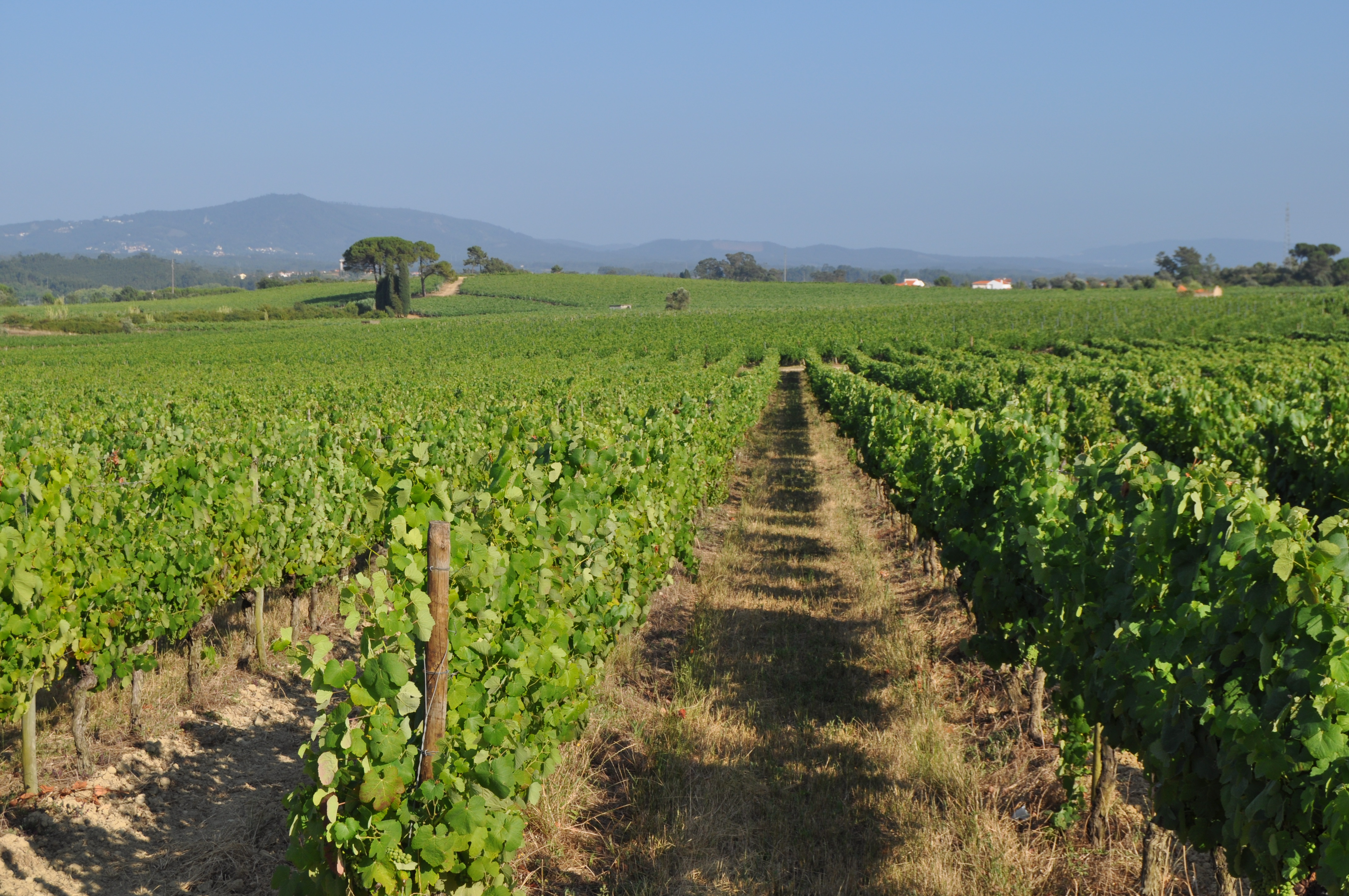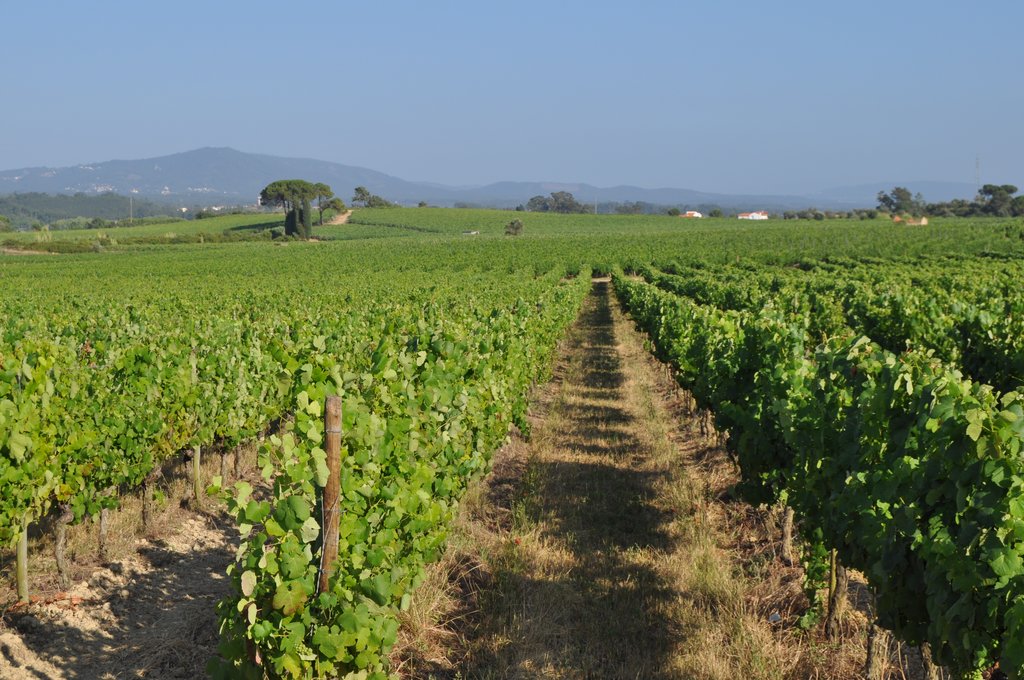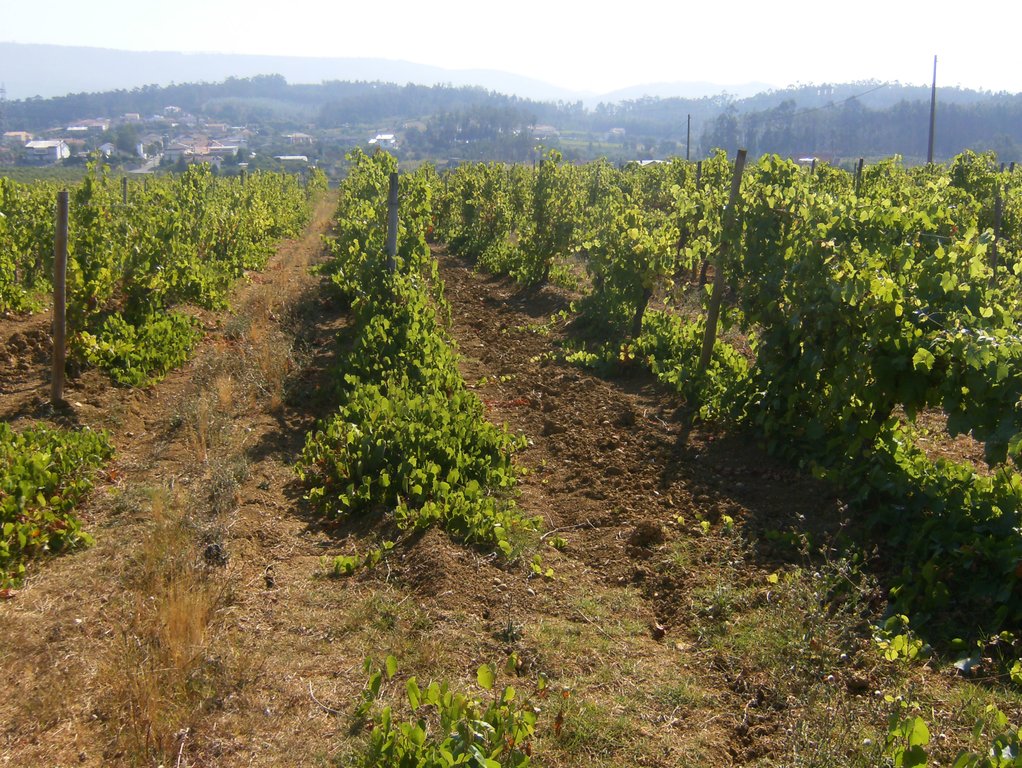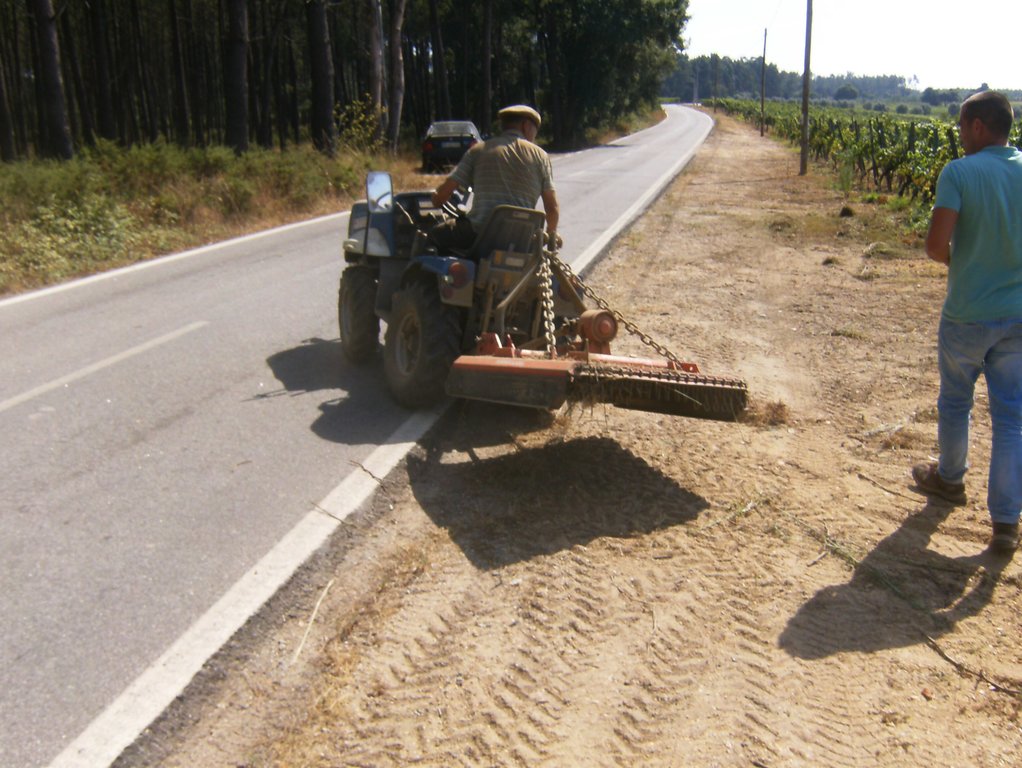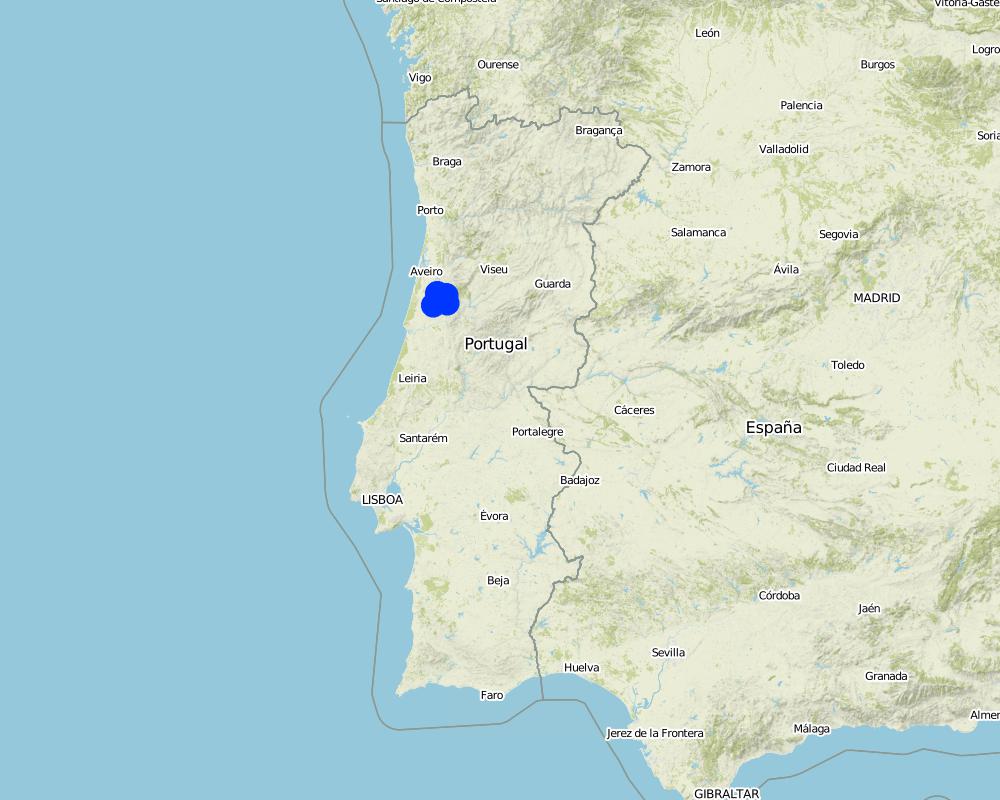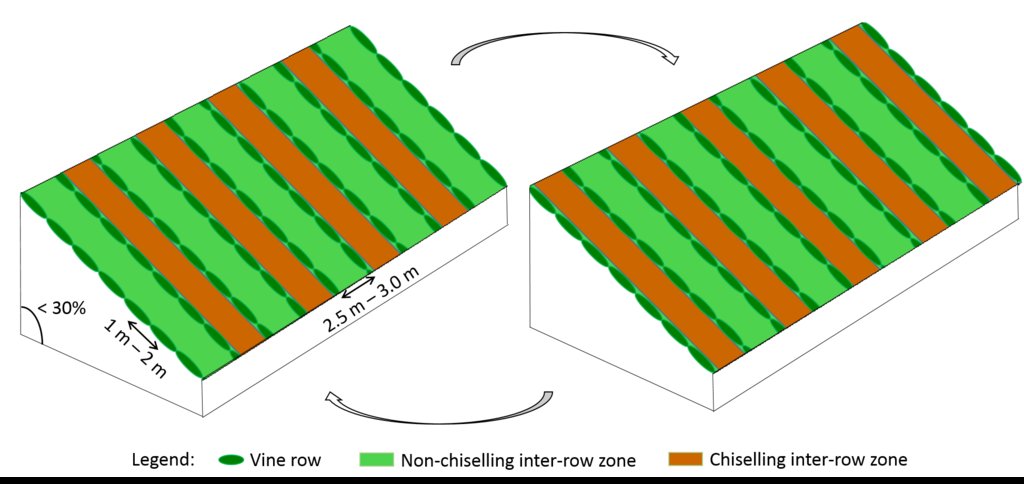Minimum tillage in Mediterranean vineyards [葡萄牙]
- 创建:
- 更新:
- 编制者: Carla Ferreira
- 编辑者: –
- 审查者: Ursula Gaemperli, Gudrun Schwilch, Alexandra Gavilano
Minimum tillage
technologies_2879 - 葡萄牙
查看章节
全部展开 全部收起1. 一般信息
1.2 参与该技术评估和文件编制的资源人员和机构的联系方式
SLM专业人员:
有助于对技术进行记录/评估的项目名称(如相关)
Interactive Soil Quality assessment in Europe and China for Agricultural productivity and Environmental Resilience (EU-iSQAPER)有助于对技术进行记录/评估的机构名称(如相关)
Centro de Estudos de Rescursos Naturais, Ambiente e Sociedade (CERNAS) - 葡萄牙1.3 关于使用通过WOCAT记录的数据的条件
编制者和关键资源人员接受有关使用通过WOCAT记录数据的条件。:
是
1.4 所述技术的可持续性声明
这里所描述的技术在土地退化方面是否存在问题,导致无法被认为是一种可持续的土地管理技术?:
否
2. SLM技术的说明
2.1 技术简介
技术定义:
Minimum tillage in vineyards is performed in alternated inter-row zone, to promote soil decompation and maintain partial vegetation cover.
2.2 技术的详细说明
说明:
Portugal is one of the larger wine producers in Europe, with vineyard area covering 27% of permanent crops. Vineyards play an important role in the Portuguese economy, not only due to the impact of wine industry but also the important cultural heritage and great influence on tourism sector. There are thirteen specialized wine regions in the country, from which we highlight Bairrada region, located in central mainland, where minimum tillage is becoming popular. Bairrada has a Mediterranean climate, characterized by a long dry summer, although the strong influence of the Atlantic Ocean. Vineyard is the most relevant crop in Bairrada. In this region, farmland is mostly cultivated by landowners, comprising small winegrowers (5-10ha), most of them members of local farmers associations, as well as large producers (100-500ha) with a relevant position in the world wine market.
In vineyards, tillage is performed to promote de-compaction of the typical medium/fine soils and weeds control. In Bairrada wine region, soil tillage is usually performed twice per year – in autumn and spring, depending on weather conditions. Tillage is performed with a ripper and disc arrow (10-15cm), since mechanized vineyards require vines arranged according to horizontal wire bundles. However, tillage activities favour soil degradation, namely due to soil erosion and increasing mineralization of organic matter. In order to mitigate land degradation, minimum tillage of inter-row zone was adopted. No tillage is not applied by the farmers due to the need to de-compact the soil, favoured by the relatively high clay content. The minimum tillage is performed in alternated inter-rows, to keep vegetation cover in part of the vineyard. Tillage inter-row switch every time, so that each inter-row is not tilled more than once per year. Weeds control in the non-tilled inter-rows is performed using a rotary brush mower. In the plant zone, weeds are controlled with herbicides, applied twice per year: autumn-winter (before vine plant winding) and spring-summer (during vegetative growth). During the hot dry summer, weeds are naturally controlled due to water-stress. Mechanical intervention is also performed for pest and disease control, generally applied as preventive measures. Phytosanitary treatments are performed upon receipt of notices from Regional Directorate of Agriculture or technicians from local farmers association. These notices also include recommendations about the type of products and the application rate. In the majority of the Region, pruning and harvesting is performed manually. Pruning residues are typically mowed and left at the soil surface.
The adoption of minimum tillage was triggered by governmental subsidies. Farmers recognize the impact of this technology on the environment, namely on preventing soil degradation and enhancing biodiversity. However, soil compaction and water competition between vegetation cover and vines (over the summer) are major concerns.
2.3 技术照片
2.5 已应用该技术的、本评估所涵盖的国家/地区/地点
国家:
葡萄牙
区域/州/省:
Bairrada, Central Region
具体说明该技术的分布:
- 均匀地分布在一个区域
如果不知道精确的区域,请注明大致覆盖的区域:
- 100-1,000 平方千米
Map
×2.6 实施日期
如果不知道确切的年份,请说明大概的日期:
- 不到10年前(最近)
2.7 技术介绍
- motivated by financial support from the government
注释(项目类型等):
Technical recommendations provided by technicians of farmers associations.
3. SLM技术的分类
3.1 该技术的主要目的
- 减少、预防、恢复土地退化
3.2 应用该技术的当前土地利用类型

农田
- 乔木与灌木的种植
乔木和灌木种植 - 指定作物:
- 葡萄
每年的生长季节数:
- 1
具体说明:
One harvesting per year
注释:
Main crops (cash and food crops): Vineyard
3.4 供水
该技术所应用土地的供水:
- 雨养
3.5 该技术所属的SLM组
- 改良的地面/植被覆盖
- 最小的土壤扰动
3.6 包含该技术的可持续土地管理措施

农艺措施
- A1:植被和土壤覆盖层
- A3:土壤表面处理
A3:区分耕作制度:
A 3.2: Reduced tillage (> 30% soil cover)
3.7 该技术强调的主要土地退化类型

土壤水蚀
- Wt:表土流失/地表侵蚀

物理性土壤退化
- Pc:压实
3.8 防止、减少或恢复土地退化
具体数量名该技术与土地退化有关的目标:
- 减少土地退化
4. 技术规范、实施活动、投入和成本
4.1 该技术的技术图纸
技术规范(与技术图纸相关):
Minimum tillage in vineyards is performed in the inter-row zone, in alternated lines switching between chiselling activities (10-15cm), usually performed in autumn and spring. There is no specific technical recommendations.
Vines are disposed horizontally, supported by wire or cord sustained by wood or metal support. Planting compass varies with soil fertility, type of wine, as well as expected quantity and quality of production, and desired height of the edges. Typically, distance between vine plants within each row ranges from 1m to 2m, and the inter-rows distance from 2.5m to 3.0m, leading to densities of 1000-3000 vines/ha. Generally vineyards are installed on natural surface profile for slopes lower than 30%, and in terraces for hillslopes of 30-50%. Vine plantation is forbidden for slopes greater than 50%.
作者:
Carla Ferreira
日期:
26/06/2017
4.2 有关投入和成本计算的一般信息
具体说明成本和投入是如何计算的:
- 每个技术区域
注明尺寸和面积单位:
1 ha per year
其它/国家货币(具体说明):
euro
如相关,注明美元与当地货币的汇率(例如1美元=79.9巴西雷亚尔):1美元=:
0.86615
注明雇用劳工的每日平均工资成本:
30
4.3 技术建立活动
| 活动 | 时间(季度) | |
|---|---|---|
| 1. | Chiselling of alternated inter-row zone | Autumn/Spring |
| 2. | Mechanical weeds control in alternated inter-row | Autumn/Spring |
| 3. | Chemical control of weeds in plant zone | Autumn-Winter and Spring-Summer |
4.4 技术建立所需要的费用和投入
| 对投入进行具体说明 | 单位 | 数量 | 单位成本 | 每项投入的总成本 | 土地使用者承担的成本% | |
|---|---|---|---|---|---|---|
| 设备 | Chisel | Equipment | 1.0 | 1000.0 | 1000.0 | 100.0 |
| 设备 | Rotary brush mower | Equipment | 1.0 | 1600.0 | 1600.0 | 100.0 |
| 设备 | Sprayer | Equipment | 1.0 | 2500.0 | 2500.0 | 100.0 |
| 技术建立所需总成本 | 5100.0 | |||||
| 技术建立总成本,美元 | 5888.13 | |||||
如果土地使用者负担的费用少于100%,请注明由谁负担其余费用:
Young farmers (<40 years old) may submit agricultural projects for partial government funding.
注释:
The costs provided do not include the tractor aquisition costs.
4.5 维护/经常性活动
| 活动 | 时间/频率 | |
|---|---|---|
| 1. | Weeds control with herbicides (in vine rows) | Autumn-Winter and Spring-Summer |
| 2. | Mechanical weeds control (inter-row) | Autumn/Spring |
| 3. | Chiselling (inter-row) | Autumn/Spring |
4.6 维护/经常性活动所需要的费用和投入(每年)
| 对投入进行具体说明 | 单位 | 数量 | 单位成本 | 每项投入的总成本 | 土地使用者承担的成本% | |
|---|---|---|---|---|---|---|
| 劳动力 | For chiselling activities | Person-days | 1.0 | 30.0 | 30.0 | 100.0 |
| 劳动力 | For mechanical weed control | Person-days | 1.0 | 30.0 | 30.0 | 100.0 |
| 劳动力 | For spraying of herbicides | Person-days | 1.0 | 30.0 | 30.0 | 100.0 |
| 设备 | Tractor with chisel | 2.0 | 100.0 | 200.0 | 100.0 | |
| 设备 | Tractor with rotary brush mower | 2.0 | 145.0 | 290.0 | 100.0 | |
| 设备 | Tractor with spraying system | 1.0 | 150.0 | 150.0 | 100.0 | |
| 肥料和杀菌剂 | Herbicides | Litres | 6.0 | 12.0 | 72.0 | 100.0 |
| 技术维护所需总成本 | 802.0 | |||||
| 技术维护总成本,美元 | 925.94 | |||||
4.7 影响成本的最重要因素
描述影响成本的最决定性因素:
Machinery and labor
5. 自然和人文环境
5.1 气候
年降雨量
- < 250毫米
- 251-500毫米
- 501-750毫米
- 751-1,000毫米
- 1,001-1,500毫米
- 1,501-2,000毫米
- 2,001-3,000毫米
- 3,001-4,000毫米
- > 4,000毫米
指定年平均降雨量(若已知),单位为mm:
1077.00
有关降雨的规范/注释:
The climate is Mediterranean but with a significant influence of the Atlantic Ocean. The dry season extends from July to September and the rainiest period extends from November to February.
注明所考虑的参考气象站名称:
10G/01UG from the Sistema Nacional de Informação de Recursos Hídricos
农业气候带
- 半湿润
Csb according with Köppen climatic classification.
5.2 地形
平均坡度:
- 水平(0-2%)
- 缓降(3-5%)
- 平缓(6-10%)
- 滚坡(11-15%)
- 崎岖(16-30%)
- 陡峭(31-60%)
- 非常陡峭(>60%)
地形:
- 高原/平原
- 山脊
- 山坡
- 山地斜坡
- 麓坡
- 谷底
垂直分布带:
- 0-100 m a.s.l.
- 101-500 m a.s.l.
- 501-1,000 m a.s.l.
- 1,001-1,500 m a.s.l.
- 1,501-2,000 m a.s.l.
- 2,001-2,500 m a.s.l.
- 2,501-3,000 m a.s.l.
- 3,001-4,000 m a.s.l.
- > 4,000 m a.s.l.
说明该技术是否专门应用于:
- 不相关
关于地形的注释和进一步规范:
Óis do Bairro: 5%; São Lourenço: 10%; Estação Vitivinícola: 9%; Quinta do Valdoeiro: 10%; Pocariça: 14%. Altitude ranges from 25m to 55 m a.s.l.
5.3 土壤
平均土层深度:
- 非常浅(0-20厘米)
- 浅(21-50厘米)
- 中等深度(51-80厘米)
- 深(81-120厘米)
- 非常深(> 120厘米)
土壤质地(表土):
- 中粒(壤土、粉土)
- 细粒/重质(粘土)
土壤质地(地表以下> 20厘米):
- 中粒(壤土、粉土)
- 细粒/重质(粘土)
表土有机质:
- 中(1-3%)
- 低(<1%)
5.4 水资源可用性和质量
地下水位表:
5-50米
地表水的可用性:
匮乏/没有
水质(未处理):
仅供农业使用(灌溉)
水的盐度有问题吗?:
否
该区域正在发生洪水吗?:
否
5.5 生物多样性
物种多样性:
- 低
栖息地多样性:
- 低
关于生物多样性的注释和进一步规范:
There is a lack of studies regarding biodiversity.
5.6 应用该技术的土地使用者的特征
定栖或游牧:
- 定栖的
生产系统的市场定位:
- 混合(生计/商业)
- 商业/市场
非农收入:
- 低于全部收入的10%
- > 收入的50%
相对财富水平:
- 平均水平
- 丰富
个人或集体:
- 个人/家庭
- 合作社
机械化水平:
- 手工作业
- 机械化/电动
性别:
- 男人
土地使用者的年龄:
- 中年人
- 老年人
说明土地使用者的其他有关特征:
Some of the farmers belong to large wine companies, which export the wine to several countries
5.7 应用该技术的土地使用者使用的平均土地面积
- < 0.5 公顷
- 0.5-1 公顷
- 1-2 公顷
- 2-5公顷
- 5-15公顷
- 15-50公顷
- 50-100公顷
- 100-500公顷
- 500-1,000公顷
- 1,000-10,000公顷
- > 10,000公顷
这被认为是小规模、中规模还是大规模的(参照当地实际情况)?:
- 中等规模的
- 大规模的
注释:
The area of land varies a lot. Individual farmers can have vineyards from 2-15ha, whereas large wine companies own up to 400 ha of vineyards in Bairrada region.
5.8 土地所有权、土地使用权和水使用权
土地所有权:
- 公司
- 个人,未命名
土地使用权:
- 个人
用水权:
- 自由进入(无组织)
注释:
The state also own some vineyards devoted to research.
5.9 进入服务和基础设施的通道
健康:
- 贫瘠
- 适度的
- 好
教育:
- 贫瘠
- 适度的
- 好
技术援助:
- 贫瘠
- 适度的
- 好
就业(例如非农):
- 贫瘠
- 适度的
- 好
市场:
- 贫瘠
- 适度的
- 好
能源:
- 贫瘠
- 适度的
- 好
道路和交通:
- 贫瘠
- 适度的
- 好
饮用水和卫生设施:
- 贫瘠
- 适度的
- 好
金融服务:
- 贫瘠
- 适度的
- 好
6. 影响和结论性说明
6.1 该技术的现场影响
社会经济效应
生产
土地管理
注释/具体说明:
There are no measurements.
水资源可用性和质量
灌溉用水的质量
注释/具体说明:
Although there are no measurements, it is expected less sediment and nutrient export (linked to decreasing runoff), thus less impacts on aquatic ecossystems.
收入和成本
工作量
注释/具体说明:
Associated with decreasing chiseling activities
社会文化影响
娱乐机会
注释/具体说明:
Vineyards are relevant for tourism, thus, their sustainability is relevant.
SLM/土地退化知识
注释/具体说明:
Farmers associations provide knowladge and trainning to farmers.
生态影响
水循环/径流
水量
注释/具体说明:
Not measured, but available water in the water cycle is expected.
水质
注释/具体说明:
There is no data, but decreasing runoff will contribute for lower sediment and nutrient exports, thus, improving water quality.
地表径流
土壤
土壤水分
注释/具体说明:
There are no measurements, but field studies performed elsewhere report increasing soil moisture due to vegetation cover.
土壤覆盖层
注释/具体说明:
Maintenance of vegetation cover in half of the vineyard inter-rows. However, vegetation cover is limited during dry periods.
土壤流失
注释/具体说明:
Based on bibliography.
土壤压实
注释/具体说明:
Although there are no measurements, farmers report that ploughing activities are relevant to reduce soil compaction.
土壤有机物/地下C
注释/具体说明:
According with literature review, minimum tillage decrease the mineralization of organic matter.
生物多样性:植被、动物
植被覆盖
注释/具体说明:
Not measured.
有益物种
注释/具体说明:
Not measured, but expected given the partia maintenance of vegetation cover.
6.2 该技术的场外影响已经显现
下游洪水
注释/具体说明:
Decreasing runoff will contribute for decreasing downstream flooding
下游淤积
注释/具体说明:
Less runoff and erosion will decrease downstream siltation.
地下水/河流污染
注释/具体说明:
Less runoff will provide lower sediment and nutrient exports to rivers.
温室气体的影响
注释/具体说明:
Lower tractor activities contribute for less greenhouse gases emission.
对场外影响(测量)的评估进行具体说明:
The impacts have not been measured. The response is based on literature review and field observations.
6.3 技术对渐变气候以及与气候相关的极端情况/灾害的暴露和敏感性(土地使用者认为的极端情况/灾害)
注释:
The technology does not have an impact on climate related issues.
6.4 成本效益分析
技术收益与技术建立成本相比如何(从土地使用者的角度看)?
短期回报:
中性/平衡
长期回报:
中性/平衡
技术收益与技术维护成本/经常性成本相比如何(从土地使用者的角度看)?
短期回报:
稍微积极
长期回报:
稍微积极
6.5 技术采用
- 11-50%
在所有采用这项技术的人当中,有多少人是自发的,即未获得任何物质奖励/付款?:
- 0-10%
6.6 适应
最近是否对该技术进行了修改以适应不断变化的条件?:
否
6.7 该技术的优点/长处/机会
| 土地使用者眼中的长处/优势/机会 |
|---|
| Less herbicides and ploughing decreases maintenance costs. |
| It allows to reduce herbicide application to control weeds, thus favouring biodiversity. |
| 编制者或其他关键资源人员认为的长处/优势/机会 |
|---|
| Minimum tillage is best suited for heavy, compacted and/or poorly drained soils, typical of vineyards. |
| It reduces land degradation, by improving soil structure and vegetation cover, important to reduce soil erosion. |
| Improving soil cover will improve soil moisture and aeration conditions, relevant for crop development and soil biodiversity. |
6.8 技术的弱点/缺点/风险及其克服方法
| 土地使用者认为的弱点/缺点/风险 | 如何克服它们? |
|---|---|
| Soil compaction due to lower ploughing | Improve soil structure |
| 编制者或其他关键资源人员认为的弱点/缺点/风险 | 如何克服它们? |
|---|---|
| Difficulty to maintain inter-row vegetation cover during the dry season | Replace vegetation cover by other materials (e.g. mulching) |
7. 参考和链接
7.1 信息的方法/来源
- 实地考察、实地调查
More than 10 field visits were performed over a three month period.
- 与土地使用者的访谈
Seven
- 与SLM专业人员/专家的访谈
Two
- 根据报告和其他现有文档进行编译
Several
(现场)数据是什么时候汇编的?:
01/05/2017
7.3 链接到网络上的相关信息
标题/说明:
Biddoccu, M., Ferraris, S., Pitacco, A., Cavallo, E. (2017). Temporal variability of soil management effects on soil hydrological properties, runoff and erosion at the field scale in a hillslope vineyard, North-West Italy. Soil & Tillage Research 165, 46–58.
URL:
http://ac.els-cdn.com/S0167198716301386/1-s2.0-S0167198716301386-main.pdf?_tid=22418bb0-5b58-11e7-980c-00000aab0f6c&acdnat=1498582154_0fb04affbfbcf3f6e729ccdd354527ee
标题/说明:
Byrne, S., Guire, L.M. (2005) Vineyard Floor Management. Final report to Grape and Wine Research & Development Corporation (RT 04/03-1)
URL:
http://www.mvwi.com.au/items/526/Vineyard%20Floor%20Management%20RT%2004%2003%201.pdf
标题/说明:
Cruz, A., Botelho, M., Silvestre, J., Castro R. (2012) Soil management: Introduction of tillage in a vineyard with a long-term natural cover. Journal of Viticulture and Enology 27(1), 27-38.
URL:
http://www.scielo.mec.pt/pdf/ctv/v27n1/v27n1a03.pdf
标题/说明:
Napoli, M., Marta, A.D., Zanchi, C.A., Orlandini, S. (2017). Assessment of soil and nutrient losses by runoff under different soil management practices in an Italian hilly vineyard. Soil & Tillage Research 168, 71–80.
URL:
http://ac.els-cdn.com/S0167198716302604/1-s2.0-S0167198716302604-main.pdf?_tid=34c1a784-5b58-11e7-8e6a-00000aacb35d&acdnat=1498582186_a97504bbec990b26b9de92901fae9b9b
标题/说明:
Puig-Montserrat, X., Stefanescu, C., Torre, I., Palet, J., Fàbregas, E., Dantart, J., Arrizabalaga, A., Flaquer, C. (2017). Effects of organic and conventional crop management on vineyard biodiversity. Agriculture, Ecosystems and Environment 243, 19–26.
URL:
http://ac.els-cdn.com/S0167880917301603/1-s2.0-S0167880917301603-main.pdf?_tid=1428ce58-5b58-11e7-a61a-00000aacb361&acdnat=1498582131_0ca1f7a72aa834a0345b38122a2f7a05
标题/说明:
Raclot, D., Bissonnais, Y.L., Louchart, X., Andrieux, P., Moussa, R., Volts, M. (2009). Soil tillage and scale effects on erosion from fields to catchment in a Mediterranean vineyard area. Agriculture, Ecosystems and Environment 134, 201–210.
URL:
http://ac.els-cdn.com/S0167880909002023/1-s2.0-S0167880909002023-main.pdf?_tid=3a75799e-5b58-11e7-8adf-00000aab0f6b&acdnat=1498582195_b808271c0c5bcddc3fa189cccc11fea3
链接和模块
全部展开 全部收起链接
无链接
模块
无模块


